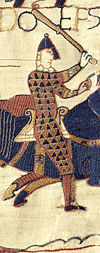Embroidery

Embroidery is the art or handicraft of decorating fabric or other materials with designs stitched in strands of thread or yarn using a needle. Embroidery may also use other materials such as metal strips, pearls, beads, quills, and sequins. Sewing machines can be used to create machine embroidery.
Contents |
Types
Embroidery is classified according to the use of the underlying foundation fabric. One classification system divides embroidery styles according to the relationship of stitch placement to the fabric.
Free
In free embroidery, designs are applied without regard to the weave of the underlying fabric. Examples include crewel and traditional Chinese embroidery.
Counted thread
Counted-thread embroidery patterns are created by making stitches over a pre-determined number of threads in the foundation fabric. Counted-thread embroidery is more easily worked on an even-weave foundation fabric such as embroidery canvas, aida cloth, or specially woven cotton and linen fabrics although non-evenweave linen is used as well. Examples include needlepoint and cross-stitch.
Second division
A second division classifies embroidery according to whether the design is stitched on top of or through the foundation fabric:
In Surface embroidery, patterns are worked on top of the foundation fabric using decorative stitches and laid threads. Surface embroidery encompasses most free embroidery as well as some forms of counted-thread embroidery (such as cross-stitch).
Canvas work threads are stitched through a fabric mesh to create a dense pattern that completely covers the foundation fabric. Not all canvas work is counted-thread embroidery. There are printed and hand painted canvases where the painted or printed image is meant to serve as a color guide. Stitches are sometimes of the stitcher's choosing.
An important distinction between canvas work and surface embroidery is that surface work requires the use of an embroidery hoop or frame to stretch the material and ensure even stitching tension that prevents pattern distortion. Canvas work tends to follow very symmetrical counted stitching patterns with designs developing from repetition of one or only a few similar stitches in a variety of thread hues. Most forms of surface embroidery, by contrast, are distinguished by a wide range of different stitching patterns used in a single piece of work.
Ribbon
Ribbon embroidery is embroidery performed with ribbon rather than standard six-thread string. Silk ribbon or a silk/organza blend ribbon are commonly used for this type of embroidery. There are many different styles of ribbon embroidery, such as woven rose, French knot, feather stitch, fly stitch, fly stitch fern, couching stitch, lazy daisy, looped petal flower, Japanese ribbon stitch, stem stitch rose, split stitch, and straight stitch. Those are usually taught to beginners who are just learning silk ribbon embroidery. Ribbon embroidery is most commonly used to create floral motifs. It's said to have a certain romantic and antique quality.
Machine
In Machine embroidery, Embroidery designs are stitched with an automated embroidery machine. These designs are "digitized" with embroidery software. They can have different types of "fills" which add texture and design to the embroidery. Almost all basic types of embroidery can be created with machine embroidery. These include: applique, free-standing lace, cutwork, cross-stitch, photo stitch, and basic embroidery. Most often this type of embroidery is associated with business shirts, gifts, team apparel and commercial use.
History
The origins of embroidery are lost in time, but examples survive from ancient Egypt, Iron Age Northern Europe and Zhou Dynasty China. It has many roots all around the world and is being done in many different ways because of their cultures....
Elaborately embroidered clothing, religious objects, and household items have been a mark of wealth and status in many cultures including ancient Persia, India, Byzantium, medieval England (Opus Anglicanum or "English work"), and Baroque Europe.
Hand embroidery is a traditional art form passed from generation to generation in many cultures, including northern Vietnam, Mexico, and eastern Europe.
The Bayeux Tapestry is not a true tapestry; it is an elaborately embroidered wall hanging originally displayed at the Bayeux Cathedral, and now housed at a special museum in Bayeux, Normandy.
Gallery
Notes
Additional Information
- S.F.A. Caulfield and B.C. Saward, The Dictionary of Needlework, 1885.
- Virginia Churchill Bath, Needlework in America, Viking Press, 1979 ISBN 0-670-50575-7
- Readers Digest Complete Guide to Needlework, 1979, ISBN 0-89577-059-8.
- Di van Niekerk, 'A Perfect World in Ribbon Embroidery and Stumpwork', 2006, ISBN 1-84448-231-6
External links
- Kalocsa Embroidery - Hungarian pieces of folk art
- Glossary of Embroidery Terms
- Examples of hand ball embroidery from Japan
- Virtual Museum of Textile Arts
- Embroidery Handbook
- "Embroidery". Textiles. Victoria and Albert Museum. Retrieved on 2008-07-01.
|
||||||||||||||||||||||||||||

